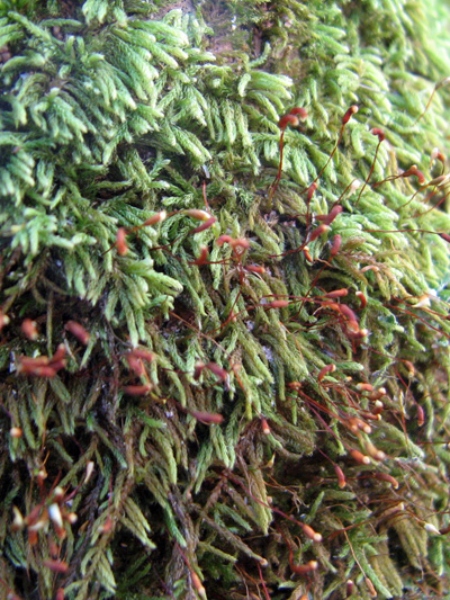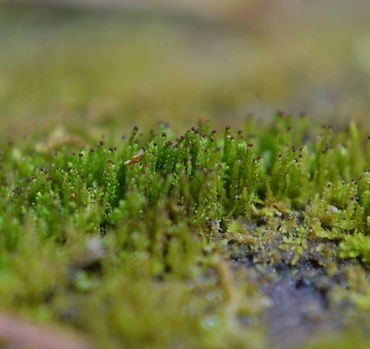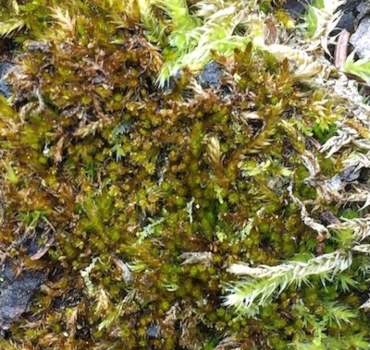Section 7.2
Status of Mosses
Willow Feather-moss (Hygroamblystegium varium)
93.3% intact on average
The status of 21 moss species associated with old deciduous and mixedwood habitat in the Al-Pac FMA area is, on average, 93.3% as measured by the Biodiversity Intactness Index.
This means most of the habitat for old forest mosses is in good condition, but habitat suitability is lower in some areas due to human development activities.
 Introduction
Introduction
Intactness and sector effects are summarized for moss species associated with old deciduous and mixedwood forests in the Al-Pac FMA area and AEI.

Largetooth Calcareous Moss (Mnium spinulosum)
Photo: ABMI

Lesser Plait Moss (Hypnum pallescens)
Photo: ABMI
Principle 8: Monitoring and Assessment
Criterion 8.2 – Monitoring and evaluating environmental and social impacts of activities carried out in the management unit
FSC Indicator 8.2.3 (3) is supported by providing up-to-date ‘best available information’ on the status of naturally occurring native species from six taxa that can inform on the effectiveness of conservation and restoration actions taken within the FMA over time (linked to FSC Criterion 6.6).
 Results
Results
Intactness of 21 moss species associated with old deciduous and mixedwood forests was found to be, on average:
Highlights
- Habitat suitability for most old forest moss species is predicted to have declined between 2010 and 2016 as indicated by the drop in intactness over this time frame. Habitat suitability was reduced the most for Largetooth Calcareous Moss (85.1% in 2010 to 82.3% in 2016) and Heller's Notchwort (87.9% in 2010 to 85.5% in 2016).
- Old-forest mosses are disproportionately affected by human footprint because, as of 2017, 54% of human footprint had occurred in deciduous and mixedwood forest, compared to other vegetation types. Human footprint in the FMA area has reduced forest older than 100 years, including lowland and upland, by 25.2% (compared to what would have been present without footprint). However, climate fluctuations and fire suppression in past decades produced a large area of maturing forest that will likely result in increasing areas of older forest for the next two or three decades, depending on fire and harvest rates. Again, intactness reflects the loss of older forest to human footprint, not the recruitment of old forest due to historical changes in fire regimes.
- Intactness of old forest mosses was higher in the Al-Pac FMA than in the AEI; this can mainly be attributed to the presence of agriculture footprint, as well as energy footprint associated with the surface mineable area in the AEI, which removes their preferred old-forest habitat.

Heller's Notchwort (Anastrophyllum hellerianum)
Photo: Oskar Gran
These results have benefited from collaboration between the ABMI and various partners and contributors. More details are available in Collaborators and Contributors.
 Sector Effects
Sector Effects
Local-footprint Sector Effects
To understand which industrial sectors are most impacting moss species associated with old deciduous-mixedwood forests in the Al-Pac FMA area, the local-footprint figures show how species' relative abundance is predicted to change within each footprint compared to the habitat it replaced (Figure: Local-footprint Sector Effects).
- All types of human disturbances decrease habitat suitability for moss species associated with old deciduous/mixedwood forests in the Al-Pac FMA area because these activities impact their preferred habitat.
- Within forestry footprint, the populations of all but two old forest moss species are predicted to be less abundant than expected compared to the habitat it replaces.
Sector Effects on Regional Moss Populations
The regional population figure shows the predicted change in the total relative abundance of old forest moss species across the Al-Pac FMA area due to each sector’s footprint (Figure: Regional Sector Effects).
- Regional effects are much less than under-footprint effects because a great deal of old forest moss habitat has not been disturbed by human footprint in the Al-Pac FMA area.
- Regional population effects of transportation, energy and urban/industrial footprint on mosses associated with old deciduous forest were small—between -2.0% and 0.3%.
- Forestry footprint resulted in the largest predicted changes to suitable habitat for most old forest mosses—on average -4.7%—because harvesting is the largest footprint type in the FMA area and disturbs the most native vegetation. Forestry footprint occurs primarily in three forest types: 47% of forestry footprint is in deciduous forest, 26% in White Spruce forest, and 21% in mixedwood forests.
To view species-specific sector effects, use the drop-down menu to select a species of interest.
References
Turestsky, M.R., B. Bond-Lamtery, E. Euskirchen, J. Talbot, S. Frolking, A.D. McGuire, and E-S. Tuittila. 2012. The resilience and functional role of moss in boreal and arctic ecosystems. New Phytologist 196:49-67.
Sanderson, L.A., McLaughlin, J.A., and P.M. Antunes. 2012. The last great forest: a review of the status of invasive species in the North American boreal forest. Forestry 85(3): 329-339.
Lindo, Z., and A. Gonzalez. 2010. The bryosphere: an integral and influential component of the Earth's biosphere. Ecosystems 13:612-627.
Hazell, P., Kellner, O., Rydin, H. and L. Gustafsson. 1998. Presence and abundance of four epiphytic bryophytes in relation to density of aspen (Populus tremula) and other stand characteristics. Forest Ecology and Management 107(1-3):147-158.
Hart, S.A. and H.Y.H. Chen. 2008. Fire, Logging, and overstory affect understory abundance, diversity and composition in boreal forest. Ecological Monographs 78(1):123-140.
Caners, R.T., MacDonald, S.E., and R.J. Belland. 2013. Bryophyte assemblage structure after partial harvesting in boreal mixedwood forest depends on residual canopy abundance and composition. Forest Ecology and Management (289): 489-500.

Flat-brocade Moss (Platygyrium repens)
Photo: ABMI





